How to Use International Mail-Order Safely and Legally for Medications (2025 Guide)
Buying prescription meds from overseas used to be simple. You found a website, paid with a credit card, and waited a couple of weeks for your package to show up. But as of August 29, 2025, that’s no longer true - not in the U.S., and not in most countries following similar rules. The $800 duty-free threshold is gone. What used to be a $50 order for insulin or blood pressure pills from Canada or India is now a legal minefield. If you’re trying to save money on medications through international mail-order, you need to know the new rules - or risk having your package seized, fined, or worse.
Why the Rules Changed (And What It Means for You)
The U.S. Customs and Border Protection (CBP) ended the $800 de minimis rule that let small packages slip through without taxes or duties. This wasn’t just a tweak - it was a full overhaul. Before August 2025, over 97% of international mail-order packages entered the U.S. duty-free. Now, only personal gifts under $100 are exempt. That means if you order $45 worth of metformin from a pharmacy in Mexico, you’re now subject to customs duties, even if it’s for personal use.
The goal? Stop the flood of unregulated pharmaceuticals entering the country. The FDA has long warned that up to 50% of online pharmacies selling prescription drugs are illegal. Many sell fake, expired, or contaminated meds. But the new rules don’t just target criminals - they hit honest people trying to afford their prescriptions. A $60 bottle of insulin from Canada might now cost $140 after duties, shipping, and paperwork. For many, that’s not a savings - it’s a barrier.
What You Can and Can’t Send (Legally)
Not all medications are treated the same. The FDA allows personal importation of unapproved drugs under very specific conditions:
- The drug is for a serious condition with no effective treatment available in the U.S.
- The drug isn’t for sale in the U.S. (like certain generics not yet approved here)
- You’re bringing in no more than a three-month supply for personal use
- You’re not selling or distributing the medication
That means insulin, certain blood thinners, and some psychiatric meds might still qualify. But antibiotics, opioids, or controlled substances like Adderall? Almost never. Even if you have a foreign prescription, U.S. customs doesn’t recognize it. They only care if the drug is FDA-approved and if you’re following the rules.
Also, avoid any pharmacy that doesn’t require a prescription. If it’s easy to buy without one, it’s illegal to ship into the U.S. - and you’re taking a huge risk. Fake pills with fentanyl have killed hundreds of Americans who thought they were buying generic painkillers from overseas sites.
The New Paperwork You Can’t Skip
Before August 2025, you might have just written “gift” on the customs form. Now, you need a full commercial invoice - and it has to be detailed. Generic terms like “medicine” or “supplement” will get your package held or returned.
You must include:
- Exact drug name (brand and generic)
- Strength and dosage form (e.g., “Metformin 500mg tablet”)
- Quantity and total value
- Manufacturer name and country of origin
- HS code (6-digit Harmonized System number - for meds, it’s usually 3004.90)
- Proof of prescription (a scanned copy attached or included)
Missing one item? Your package sits in customs for weeks. You might get a notice asking for more info - but if you don’t respond in time, it’s destroyed. No refund. No second chance.
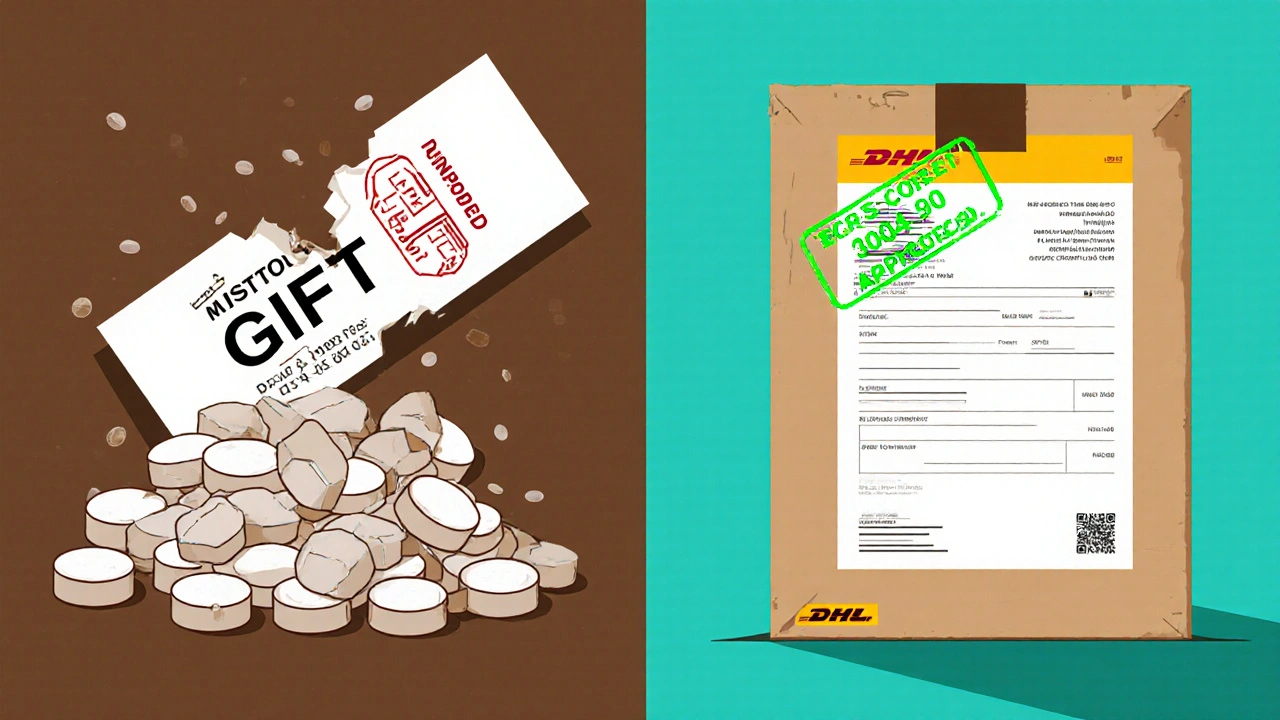
Choosing the Right Carrier (And Avoiding the Traps)
Not all shipping services handle international medication the same way. Deutsche Post, Canada Post, and many national postal services stopped accepting commercial parcels to the U.S. after August 22, 2025. That means if you’re ordering from a small overseas pharmacy, they can’t use regular mail anymore.
Your only legal options now are:
- DHL Express - They handle customs clearance as part of their service. You pay duties upfront at checkout. Most reliable for meds.
- FedEx International - Same as DHL. Requires full documentation. Good for higher-value shipments.
- UPS Worldwide - Works with bonded brokers. Best for bulk or repeat orders.
Avoid standard postal services like USPS First-Class Mail International. They don’t process commercial shipments anymore. Even if the pharmacy says they’ll ship it “as a gift,” that’s a lie. CBP checks package contents, not just labels. If they find pills, they’ll flag it as commercial - and you’ll be liable.
Duty Calculation: What You’ll Actually Pay
There are two ways duties are calculated now - and timing matters.
Until February 28, 2026: You might face a flat fee based on the country of origin:
- $80 for countries with low tariff rates (like Canada or Germany)
- $160 for medium rates (like India or China)
- $200 for high rates (rare for meds, but possible)
After February 28, 2026: Only one method remains - ad valorem. That means you pay a percentage of the item’s value. For most prescription drugs, the rate is 1.5% to 5%. So a $100 bottle of medication? Around $1.50 to $5 in duties.
Here’s the catch: The flat rate ($80-$200) might seem worse than the percentage. But if your medication is cheap - say $25 - then $80 in duties makes no sense. You’re paying more in fees than the drug costs. That’s why many small pharmacies have stopped shipping to the U.S. entirely.
How to Stay Safe (And Avoid Scams)
Here’s your checklist before you click “buy”:
- Check if the pharmacy is licensed in its home country. Look for a verifiable physical address and phone number.
- Use only pharmacies that require a valid prescription - and ask them to email you a copy.
- Verify the drug is the same as your U.S. version (same active ingredient, same dosage).
- Ask the pharmacy if they’ve shipped to the U.S. since August 2025. If they say “yes, no problem,” ask for proof - like a tracking number from DHL/FedEx.
- Never pay with crypto or wire transfer. Use PayPal or credit card so you can dispute if it’s fake or seized.
Red flags: No contact info, prices way below U.S. retail, “no prescription needed,” or “guaranteed delivery.” If it sounds too good to be true, it is.
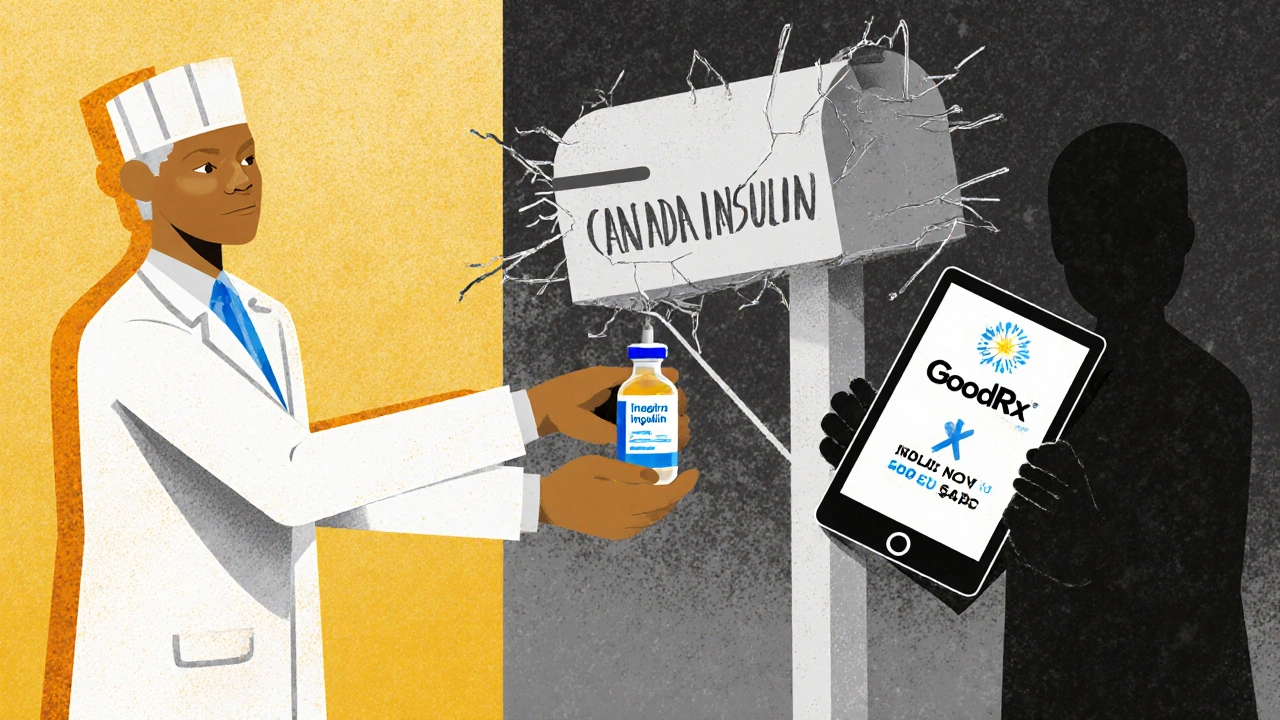
What Happens If Your Package Gets Stopped?
If CBP holds your package, you’ll get a notice in the mail - not an email, not a text. It could take 2-4 weeks to arrive. The notice will say why and what you need to do.
Your options:
- Pay the duty and fees - If you have the paperwork, you can pay and get it released.
- Abandon the package - You lose your money, but avoid fines.
- Appeal - Only if you’re certain the meds are legal and you have proof. This can take months.
Don’t ignore the notice. If you don’t respond, CBP destroys the meds and may flag your name for future shipments. You could be denied entry at the border if you’re traveling.
Alternatives to International Mail-Order
If the new rules make overseas orders too risky or expensive, here are better options:
- Use U.S. pharmacy discount programs - GoodRx, SingleCare, and RxSaver often cut drug prices by 70-80%.
- Ask your doctor about generic alternatives - Many brand-name drugs have cheaper generics approved in the U.S.
- Check patient assistance programs - Most major drugmakers offer free or low-cost meds to qualifying patients.
- Buy in bulk from U.S. mail-order pharmacies - CVS, Walgreens, and others offer 90-day supplies at lower per-unit prices.
These options are legal, safe, and often cheaper than trying to navigate international shipping now.
Final Reality Check
The dream of buying cheap meds from overseas isn’t dead - but it’s changed. It’s no longer about convenience. It’s about compliance, paperwork, and cost. For most people, the savings aren’t worth the risk. The $80 duty on a $40 pill isn’t a bargain - it’s a trap.
If you still want to try, do it right: Use DHL or FedEx, get the HS code right, include your prescription, and never lie on the customs form. But be honest with yourself: Is this worth your time, money, and peace of mind?
There’s a better way. Talk to your pharmacist. Ask your doctor. Use the tools already in your country. You don’t need to risk your health - or your legal standing - to save a few bucks.
Can I still order insulin from Canada legally?
Yes - if it’s for personal use, you have a valid prescription, you’re bringing in a three-month supply or less, and you use a carrier like DHL or FedEx that handles customs clearance properly. You must declare the exact drug name, strength, and value on the commercial invoice. Avoid regular mail - it won’t clear customs anymore.
What happens if I lie and say it’s a gift?
CBP scans packages and cross-checks contents with declared values. If they find pills in a package labeled “gift,” they’ll flag it as a commercial shipment. You’ll face delays, possible fines, and your package will be destroyed. Repeated violations can lead to your name being flagged in customs databases, which could affect future travel or imports.
Do I need a U.S. prescription to order from overseas?
The U.S. doesn’t recognize foreign prescriptions. But to legally import medication for personal use, you must have a valid prescription - even if it’s from your home country. You need to include a copy with the shipment. Without it, customs will reject the package, even if the drug is legal in the U.S.
Why did DHL stop accepting packages from some pharmacies?
DHL didn’t stop accepting all packages - they stopped accepting those from pharmacies that couldn’t provide the required documentation: commercial invoices with HS codes, proof of prescription, and accurate declarations. Many overseas pharmacies weren’t prepared for the new rules. DHL now only works with vendors who meet CBP’s standards to avoid liability.
Is it cheaper to order meds from Mexico or India now?
For most people, no. Before 2025, a $30 insulin bottle from Mexico might cost $45 total with shipping. Now, with $80 in duties, you’re paying $125 - more than the U.S. price. Even with the 1.5% ad valorem rate after 2026, the added cost of shipping, customs brokerage, and paperwork often makes it not worth it. U.S. discount programs usually offer better deals.



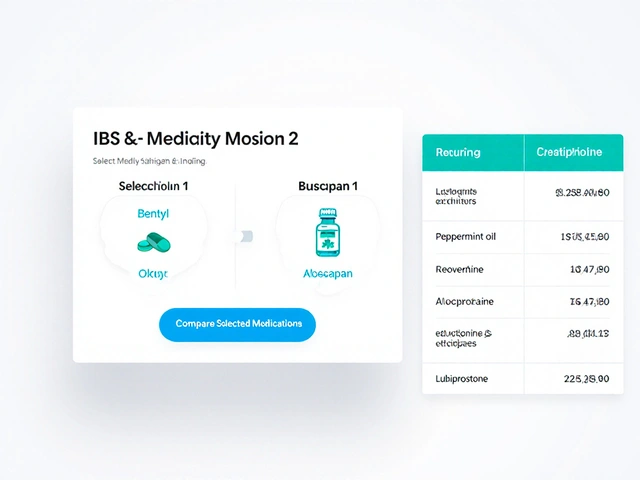
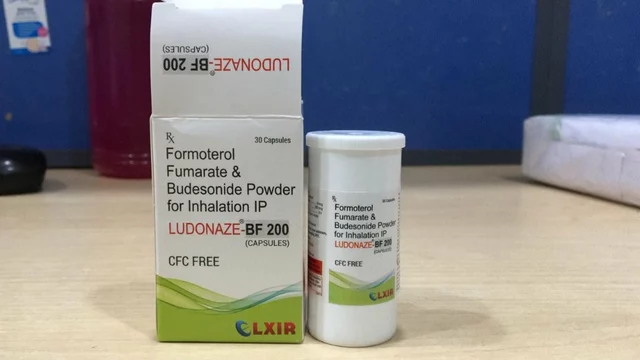
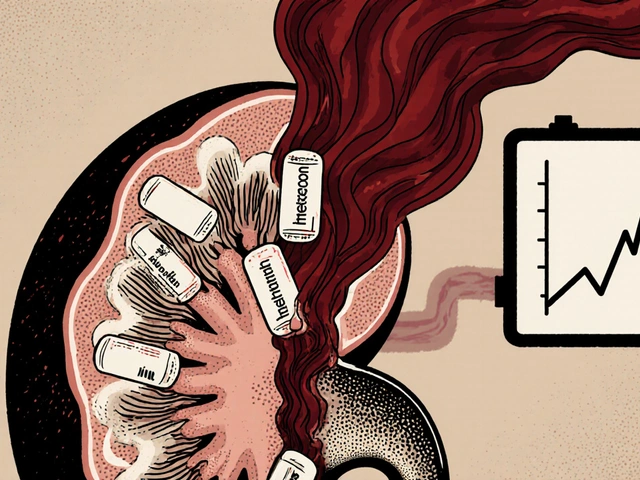
9 Comments
Conor McNamara
November 18 2025i swear the govts are just using this to make us pay more for everything
they say its about safety but honestly its just a tax grab
insulin costs 300 here but 40 in canada and now they wanna charge me 80 just to get it?
next theyll tax my water and air
im not even gonna bother ordering anymore
they can keep their paperwork and their hs codes
Leilani O'Neill
November 18 2025This is precisely why the United States must reclaim sovereignty over its pharmaceutical supply chain. Relying on foreign pharmacies is not just legally reckless-it is a national security vulnerability. The FDA’s warnings were not hyperbole. Many of these so-called "generic" drugs contain toxic fillers, unregulated active ingredients, or worse. The new regulations are not punitive-they are protective. If you cannot afford your medication in America, then your problem lies with the broken domestic system, not with customs enforcement.
Riohlo (Or Rio) Marie
November 20 2025Oh honey. Let me paint you a picture: You're a 68-year-old widow on a fixed income, taking metformin since 2012, and your pharmacy just hiked the price to $280 for a 30-day supply. You find a Canadian pharmacy that sells it for $38. You fill out the invoice, attach your prescription, pay DHL's $120 "customs handling fee," and wait three weeks while CBP "reviews" your package. Then-poof-it's gone. No refund. No apology. Just a form letter saying "unapproved pharmaceuticals prohibited."
And now you're supposed to be grateful for the "safety"? The real tragedy isn't that people are smuggling meds-it's that the system made them feel like criminals for trying to survive. This isn't regulation. It's economic violence dressed in bureaucratic lace.
steffi walsh
November 21 2025Hey everyone I just wanted to say you're not alone in this 💪
It's so hard when you're trying to do the right thing and the system feels stacked against you
I ordered my thyroid med from Germany last month and it took 5 weeks but it got through!
Just make sure you double-check every line on the invoice and use DHL
And if it gets stuck, don't panic-call your local CBP office, they're actually pretty helpful if you're polite
You got this 💗
Gabriella Jayne Bosticco
November 22 2025I’ve been using GoodRx for my blood pressure med since last year. Paid $12 for a 90-day supply. No customs forms, no risk, no waiting. I know the allure of cheaper foreign meds is strong, but the hidden costs-time, stress, legal exposure-are rarely worth it. The system’s broken, but there are still safe, legal ways to get relief. Don’t let frustration push you into danger.
Sarah Frey
November 22 2025It is imperative to underscore that the regulatory changes implemented by U.S. Customs and Border Protection are not arbitrary. They are grounded in extensive public health data indicating that a significant proportion of unregulated pharmaceutical imports contain lethal contaminants. While the financial burden on individuals is undeniable, the ethical imperative to prevent harm outweighs convenience. I encourage all readers to consult with their physicians regarding patient assistance programs, which remain underutilized and highly effective.
Katelyn Sykes
November 24 2025Just wanted to add that if you're ordering from India or Mexico make sure the pharmacy uses DHL and you have the HS code 3004.90 on the invoice or it's guaranteed to get stuck
Also never use USPS even if they say it's a gift they scan everything now
I ordered my insulin last month and it cleared in 4 days with no drama
But I did spend 3 hours filling out the form
And yes it cost $90 in fees for a $40 pill
But at least I got it
And I didn't die
Gabe Solack
November 24 2025Just want to say I’m so proud of you all for trying to navigate this mess 🙌
It’s not your fault the system is broken
And if your package got seized? That’s not on you. That’s on a system that lets Big Pharma charge $300 for insulin while letting people die for profit
Use GoodRx. Talk to your doctor. Join a patient group. You’re not alone
And if you do try international again? You’re brave. And I respect that 💙
Yash Nair
November 24 2025Why are Americans so weak? We have the best medicine in the world and you still whine about cost? Go to India and see real poverty. You think $200 for insulin is bad? Here we pay $2 for the same thing. You want cheap meds? Then stop being lazy and come to India. We have 1000s of licensed pharmacies. You think CBP is bad? Try dealing with Indian bureaucracy. At least you have DHL. We have auto rickshaws with medicine boxes. Stop crying. Fix your own system. You have the money. You have the tech. You just have no guts.